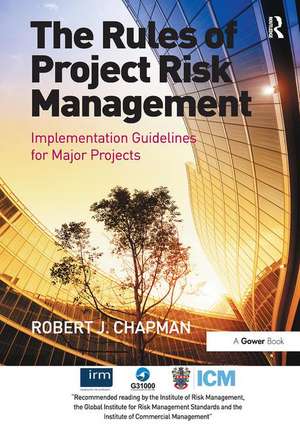The Rules of Project Risk Management: Implementation Guidelines for Major Projects
Autor Robert James Chapmanen Limba Engleză Paperback – 27 feb 2017
Preț: 482.62 lei
Nou
Puncte Express: 724
Preț estimativ în valută:
92.35€ • 96.86$ • 76.88£
92.35€ • 96.86$ • 76.88£
Carte tipărită la comandă
Livrare economică 01-15 aprilie
Preluare comenzi: 021 569.72.76
Specificații
ISBN-13: 9781138247987
ISBN-10: 1138247987
Pagini: 264
Dimensiuni: 174 x 246 x 14 mm
Greutate: 0.45 kg
Ediția:1
Editura: Taylor & Francis
Colecția Routledge
Locul publicării:Oxford, United Kingdom
ISBN-10: 1138247987
Pagini: 264
Dimensiuni: 174 x 246 x 14 mm
Greutate: 0.45 kg
Ediția:1
Editura: Taylor & Francis
Colecția Routledge
Locul publicării:Oxford, United Kingdom
Public țintă
Professional Practice & DevelopmentNotă biografică
Robert Chapman is currently the Head of Risk Management on the Klang Valley MRT project in Malaysia. He is a qualified architect and he holds both a PhD in Risk Management and, an MSc in Construction Management. He was elected, and is a Fellow of the UK IRM, APM and ICM for his contribution to the field of risk management. Robert has worked in the construction industry for over 35 years, initially as an Architect, subsequently as a Project Manager and finally as a Risk Specialist - which has been his occupation for the last 12 years. He has worked in Europe, The Middle East and Asia. He is author of Simple Tools and Techniques for Enterprise Risk Management, Second Edition, published by John Wiley and Sons Limited and Retaining Design Team Members: A Risk Management Approach, published by RIBA Enterprises Limited.
Recenzii
’This is a well-researched and authoritative book on managing risks in projects. It is written by an acknowledged expert who has devoted his lifetime career to the study and application of risk management. Its approach is aligned with the international standard, "Risk Management Principles and Guidelines", ISO 31000, and it presents key principles for managing project risks. However, the unique feature is its structure, based on 22 practical guidelines, called rules. The author suggests that, as an alternative to reading the book cover to cover, the reader might prefer to peruse individual rules when time permits. Anyone involved in project or risk management should read this book.’ Mike Nichols, Founder and Chairman of The Nichols Group, Chairman of the Association for Project Management and Board Member of the Major Projects Association ’Rob Chapman’s book is highly unusual but completely invaluable in taking a case study based approach to a subject that often is confused by an excess of jargon and process. Dr Chapman draws on an extensive international range of real projects to demonstrate how things can so easily go wrong, and what project managers can learn from high profile failures. I thoroughly recommend this book to anyone involved in project and programme management.’ Steve Fowler, CEO, The Institute of Risk Management, UK ’A unique combination of the foundations of project management and the latest trend in risk management standardisation with clear alignment with the ISO 31000 risk management standard.’ Alex Dali, President, The Global Institute for Risk Management Standards, France ’More than ever, larger, more complex and more expensive projects are required in a severely constrained global economy. The Rules of Project Risk Management is essential reading, not merely for the project management professional but for all stakeholders who have a keen interest in leveraging better results from project investments. Whether a
Descriere
The discipline of project risk management is continually evolving and has matured over time. However within the literature there has been a disproportionate focus on process, techniques and statistical analysis at the expense of understanding how effective risk management is delivered. The Rules of Project Risk Management provides readers with practical insights in the form of guidelines or ’rules’ to enhance effective delivery of a discipline which has been proven to directly contribute to securing a project’s objectives. A series of mini case studies are included to improve comprehension of the guidelines. The structure of the book has been designed to enable project and risk personnel and students alike to quickly appreciate and assimilate those aspects of risk management that warrant close scrutiny and comprehension. Robert Chapman’s advice is given with clarity and is based on very broad experience.
